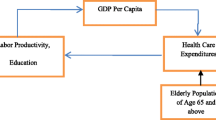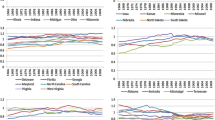Abstract
This paper examines the asymmetry (steepness and deepness asymmetry) in per capita health care expenditure and disposable income series in the 50 US states over the period 1966–2009, using the nonparametric Triples test techniques, together with the parametric Fisher–Pearson skewness test. The results suggest significant evidence of asymmetric behaviour (mainly, steepness asymmetry) in many of these series, questioning, thus, the adequacy of linear models when modelling the behaviour of these two series.
Similar content being viewed by others
Notes
Ramsey and Rothman (1996) classify asymmetry into longitudinal and transversal. They defined longitudinal asymmetry as asymmetry in the direction of the movement of the business cycle. In a similar manner, they defined transversal asymmetry as asymmetry orthogonal to the direction of the movement of the business cycle. Steepness would be a longitudinal asymmetry while deepness would be an example of transversal asymmetry.
We would like to thank Donald G. Freeman, Sam Houston State University, for providing the dataset.
All computations were done using the publicly available MATLAB codes written by Jos van der Geest.
Although the results of the triples test depend on the filter used to de-trend the series, a robust result obtained when applying both the HP and BK filters is that the evidence of deepness asymmetry is significantly weaker than the evidence of steepness asymmetry.
References
Acemoglu, D., Finkelstein, A., & Notowidigdo, M. (2013). Income and health spending: Evidence from oil price shocks. The Review of Economics and Statistics, 95, 1079–1095.
Baltagi, B., & Moscone, F. (2010). Health care expenditure and income in the OECD reconsidered: Evidence from panel data. Economic Modelling, 27, 804–811.
Baxter, M., & King, R. D. (1995). Measuring business cycles. Approximate band-pass filters for economic time series, NBER Working Paper Series 5022.
Blavin, F., Blumberg, L., Waidmann, T., & Phadera, L. (2012). Trends in US health care spending leading up to health reform. Washington, DC: The Urban Institute, Robert Wood Johnson Foundation.
Caporale, G. M., Cunado, J., Gil-Alana, L. A, & Gupta, R., (2015). The relationship between healthcare expenditure and disposable personal income in the US states: A fractional integration and cointegration analysis. CESIFO Working Paper No. 5407.
Chirila, V., & Chirila, C. (2012). Testing business cycles asymmetry in Central and Eastern European countries. Modern Economy, 3, 713–717.
Cook, S. (2006). A disaggregated analysis of asymmetrical behaviour in the UK housing market. Urban Studies, 43(11), 2067–2074.
Di Matteo, L. (2003). The income elasticity of health care spending. A comparison of parametric and nonparametric approaches. European Journal of Health Economics, 4, 20–29.
Freeman, D. G. (2003). Is health care a necessity or a luxury? Pooled estimates of income elasticity from US state-level data. Applied Economics, 35(5), 495–502.
Freeman, D. G. (2012). Is health care a necessity or a luxury? New evidence from a panel of US state-level data. Sam Houston State University, Economics and International Business Working Paper No. 12-03.
Gerdtham, U. G., & Lothgren, M. (2000). On stationarity and cointegration of international health expenditure and GDP. Journal of Health Economics, 19, 461–475.
Getzen, T. E. (2013). Modeling medical cost trends for advancing age in the long run. SSRN: http://ssrn.com.
Guemmegne, J. T., Kengwoung-Keumo, J. J., Tabatabai, M. A., & Singh, K. P. (2014). Modeling the dynamics of the US healthcare expenditure using a hyperbolastic function. Advances and Applications in Statistics, 42, 95–117.
Hartman, M., Martin, A., Lassman, D., & Catlin, A. (2015). National health spending in 2013: Growth slows, remains in step with the overall economy. Health Affairs, 34, 150–160.
Hodrick, R., & Prescott, E. C. (1997). Postwar business cycles: An empirical investigation. Journal of Money, Credit and Banking, 29, 1–16.
Hoeffding, W. (1948). A class of statistics with asymptotically normal distributions. Annals of Statistics, 19, 293–325.
Moscone, F., & Tosetti, E. (2010). Health expenditure and income in the United States. Health Economics, 19, 1385–1403.
Narayan, P. K. (2006). Examining structural breaks and growth rates in international health expenditures. Journal of Health Economics, 25, 877–890.
Narayan, P. K. (2009). Are health expenditures and GDP characterized by asymmetric behaviour? Evidence from 11 OECD countries. Applied Economics, 41, 531–536.
OECD Health Statistics. (2014). How does the United States compare? www.oecd.org/health/healthdata.
Panopoulou, E., & Patenlidis, T. (2013). Cross-state disparities in US health care expenditures. Health Economics, 22, 451–465.
Pearson, E. S., & Hartley, H. O. (1970). Biometrika tables for statisticians (3rd ed.). Cambridge: Cambridge University Press.
Peiro, A. (2004). Are business cycles asymmetric? Some European evidence. Applied Economics, 36, 335–342.
Ramsey, J., & Rothman, P. (1996). Time irreversibility and business cycle asymmetry. Journal of Money, Credit and Banking, 28, 1–21.
Randles, R. H., Flinger, M. A., Policello, G. E., & Wolfe, D. A. (1980). An asymptotically distribution free test for symmetry versus asymmetry. Journal of the American Statistical Association, 75, 168–172.
Razzak, W. A. (2001). Business cycle asymmetries: International evidence. Review of Economic Dynamics, 4, 230–243.
Sichel, D. E. (1993). Business cycle asymmetry: A deeper look. Economic Inquiry, 31, 224–236.
Verbrugge, R. (1997). Investigating cyclical asymmetries. Studies in Nonlinear Dynamics and Econometrics, 2, 15–22.
Wang, Z. (2009). The convergence of health care expenditure in the US states. Health Economics, 18, 55–70.
Yavuz, N. C., Yilanci, V., & Ozturk, Z. A. (2013). Is health care a luxury or a necessity or both? Evidence from Turkey. European Journal of Health Economics, 14, 5–10.
Zerihun, M. F., Breitenbach, M. C., & Kemegue, F. (2014). Greek wedding in SADC? Testing for structural symmetry toward SADC monetary integration. The African Finance Journal, 16(2), 16–33.
Acknowledgments
Juncal Cuñado gratefully acknowledges financial support from the Ministerio de Economía y Competitividad (ECO2014-55496).
Author information
Authors and Affiliations
Corresponding author
Rights and permissions
About this article
Cite this article
Zerihun, M.F., Cunado, J. & Gupta, R. Are Health Care Expenditures and Personal Disposable Income Characterised by Asymmetric Behaviour? Evidence from US State-Level Data. Soc Indic Res 131, 527–542 (2017). https://doi.org/10.1007/s11205-016-1275-8
Accepted:
Published:
Issue Date:
DOI: https://doi.org/10.1007/s11205-016-1275-8
Keywords
- Asymmetric behaviour
- Fisher–Pearson test
- Triples test
- Per capita real healthcare expenditure
- Per capita real personal disposable income
- US states




